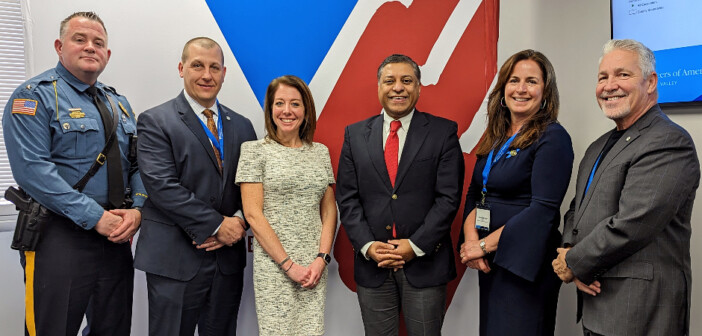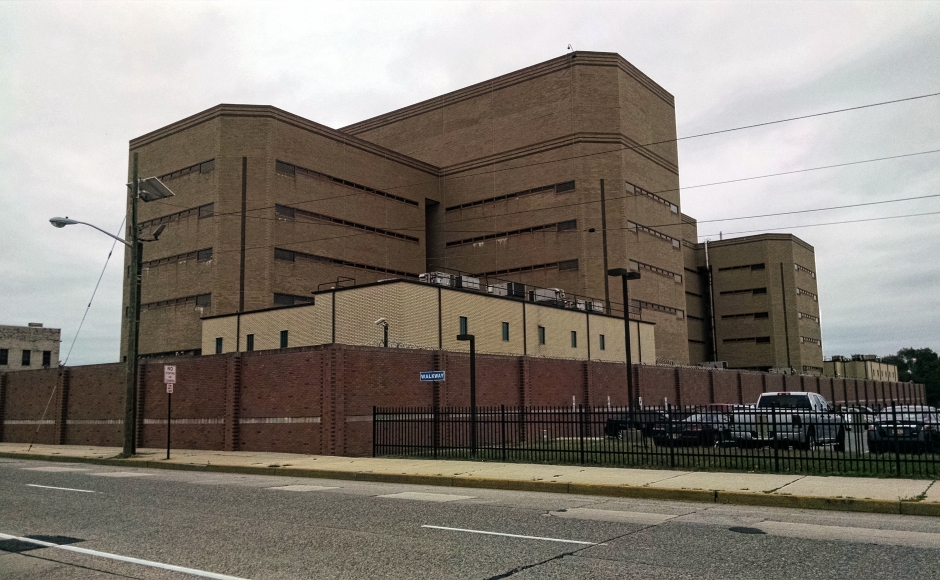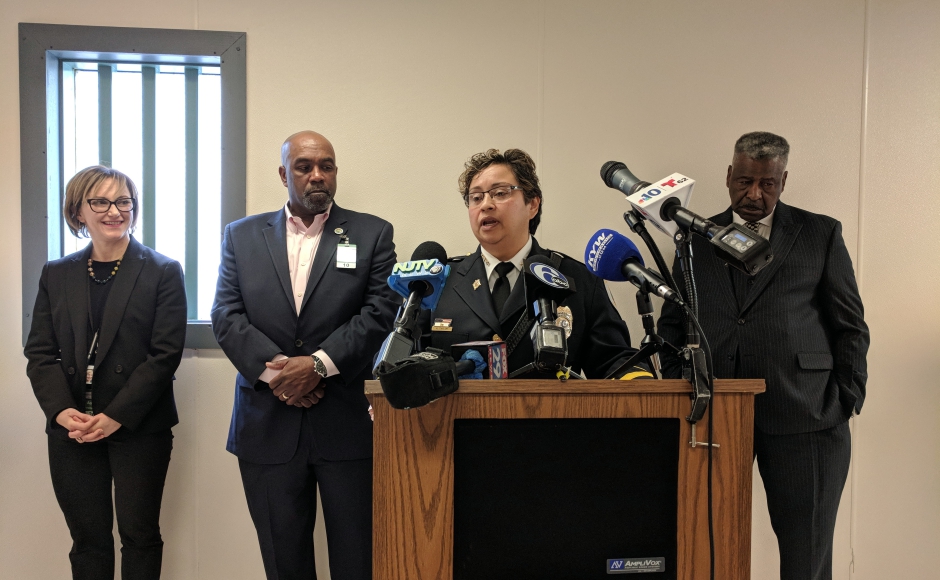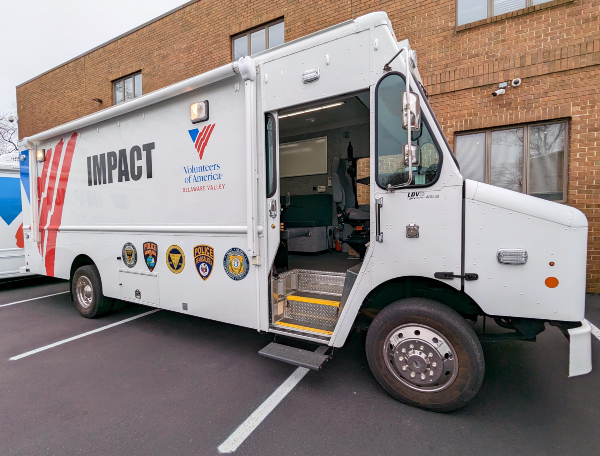Director of National Drug Control Policy Dr. Rahul Gupta meets with social services workers, law enforcement, and healthcare leaders in a tour that identifies reproducible intervention strategies.
By Matt Skoufalos | February 24, 2023
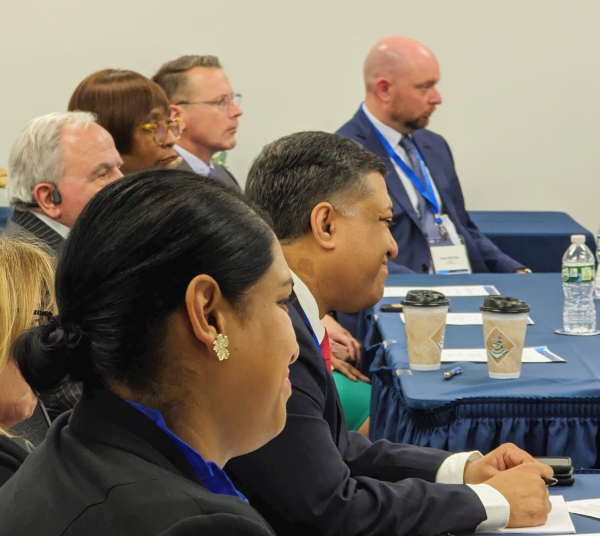
ONDCP Director Dr. Rahul Gupta meets with community leaders on addictions issues. Credit: Matt Skoufalos.
In a two-day visit to South Jersey this week, Dr. Rahul Gupta, Director of the Office of National Drug Control Policy (ONDCP), connected with a wide cross-section of people confronting the impact of addiction on their communities.
Dr. Gupta toured the Camden County jail and spoke with incarcerated people struggling to overcome addiction.
He met with representatives from Cooper University Health System about their work to stabilize overdose victims after emergency room visits with opioid-weaning medications.
Dr. Gupta also heard from Camden County law enforcement about ways to reduce recidivism by referring people battling addiction to a network of social programs coordinated through Volunteers of America Delaware Valley (VOADV).
ONDCP is working to crack down on those who profit from drug trafficking while simultaneously expanding the limited infrastructure currently available for people who need treatment and recovery services to overcome substance use disorders (SUDs).
“Almost no family is spared from this addiction crisis, which doesn’t care if you’re Black or white; rich or poor; urban or rural; Republican or Democrat,” Dr. Gupta said. “It’s an issue of national security and economic prosperity.
“People suffering from addiction need treatment, and people trafficking drugs need to meet justice and prosecution,” he said. “We have to look at it and deal with both.
“We want to make sure we’re getting people the help they need so we can get them back in the workforce, or whatever else they want to do.”
To achieve those aims means forming partnerships across the country, from the federal government on down to state, county, and local institutions, like the Camden County jail.
According to the National Institute on Drug Abuse, an estimated 65 percent of inmates in American prisons have an active SUD; another 20 percent may not fit the clinical definition for such a diagnosis, but were under the influence of drugs or alcohol at the time they committed the crimes for which they were jailed.
Without drug screening and treatment at the time of their incarceration, prisoners are more likely to re-offend upon their release, or may simply perish from the effects of withdrawal while incarcerated.
People discharged from prison without having had addictions treatment are at a 40 times greater risk of an overdose death upon re-entering their communities.
With treatment, that rate falls by 85 percent, Dr. Gupta said.
“The smuggling of drugs and weapons into prisons goes down, violence goes down, suicide attempts goes down, and corrections officers are able to deal better because they’re not seeing as much violence,” he said.
“There’s a true overlap between addiction and violence,” Dr. Gupta said. “We heard from four individuals in the jail yesterday; each of them used the words ‘fear of death,’ and ‘getting my life back.’
The Camden County jail population is showing improvements in these areas because inmates there are screened and triaged for addiction upon their incarceration, and are connected with services that help them re-enter the community safely upon their release.
“They’re seeing fewer people come back; fewer people die,” Dr. Gupta said. “Jails are a microcosm of society. It’s important to have people get help there so they can be productive citizens after [their release].”
The White House is working to replicate programs like those at the Camden County jail by making treatment available for all prisoners at 122 federal correctional facilities, and by providing state-level guidance from the Center for Medicare and Medicaid Services (CMS) to get inmates into addictions treatment for about 90 days before they re-enter society.
“This is going to be a game-changer,” Dr. Gupta said. “Every way you look at it, it’s an important, smart, timely aspect of achieving the President’s vision of universal access to care.”
Getting more people who are affected by addiction into treatment requires greater training of healthcare professionals in medication-assisted treatment (MAT), said biomedical researcher Stan Terlecky, who chairs the Department of Medical Sciences at the Hackensack Meridian School of Medicine.
Part of that barrier was removed last month with the repeal of the Drug Addiction Treatment Act (DATA) of 2000 “X-waiver.”
Physicians who were looking to prescribe harm reduction drugs like buprenorphine needed that waiver from the U.S. Substance Abuse and Mental Health Services Administration (SAMHSA) — and the education that came with it — to do so outside of an addictions treatment center.
They were limited in the number of opioid-addicted patients to whom they could prescribe such drugs, which stifled the response to a nationwide epidemic that has been spiraling for decades, and which worsened during the novel coronavirus (COVID-19) pandemic.
“The tsunami of COVID hit shores already inundated by the opioid crisis,” Terlecky said. “We have the cure. We can get you off of this stuff. Why can’t we intervene?”
Rather than condemn incarcerated people to dying of withdrawal in jail, or dying of an overdose after their release from prison, Terlecky argued that providing buprenorphine replacement drugs to people battling addiction expands the universe of treatment options, saving lives.
“[Addiction] is not about moral failings; this is about neural circuits,” Terlecky said. “It’s not about poor decision-making, it’s about limited, perceived options.”
Beyond the repeal of the DATA X-waiver, which he said only 10 percent of physicians currently have, in 2018, the Hackensack Meridian School of Medicine and Seton Hall University won a SAMHSA grant to train physicians and nurse practitioners in the pharmacology and behavioral counseling knowledge that underpins buprenorphine prescription.
The past four classes have ramped up such training from 60 to 165 physicians per class, Terlecky said, empowering a growing number of healthcare professionals to deliver MAT services to their patients battling addiction.
“Medicine moves at the pace of trust,” he said. “We’re trying to get existing physicians trained, too. I support Dr. Gupta’s call for universal access to support services by 2025.”
In addition to expanding treatment options and caring for those people battling addiction while in the custody of the state or federal government, the Collingswood-based nonprofit Volunteers of America Delaware Valley (VOADV) has spent the past three years pioneering an integrative social services model to stabilize police interactions with New Jersey residents who are suffering from addiction.
Dubbed the IMPACT program (Immediate Mobilization of Police Assisted Crisis Teams), it coordinates VOADV staff with police departments in coverage areas throughout South Jersey for a rapid response to issues that are unrelated to law enforcement.
When officers responding to calls for service identify an underlying social services need —addiction, homelessness, utility shutoffs, food insecurity, job training — they are able to rapidly connect residents with case workers who can get them help. In many cases, these interventions can also divert residents from the criminal justice system.
Pine Hill Police Chief Chris Winters oversaw the program launch in his community in December 2019; since then, it has expanded to additional, regional hubs in Voorhees and Gloucester City as well as affiliate locations throughout six other counties.
Office affiliations are selected for the program based on community need, geographic location, and departmental culture in participating police departments, Winters said, but any police department can call for services.
The program was launched in Pine Hill with a $2-million grant from the state Department of Human Services, and relies entirely on state and federal funding. Police departments do not pay to participate in the IMPACT program.
“This is a social services program funded by the state best practices to partner with law enforcement,” said Amanda Leese, VOADV Senior Vice-President of Re-Entry and Navigator. “Every year, our state appropriation determines whether we can expand the program.”
After its first year, nearly three-quarters of police referrals for services through the program resulted in people being connected to services, and that figure has remained consistent for three years running. Winters credits participants with working to establish trust with residents that it will work for them.
“When we started, I wanted to be able to have an officer look somebody in the eye at 2 in the afternoon or 2 in the morning, and ensure them that they’re going to be connected with somebody who’s going to make sure that they get to where they need to be,” he said.
“We’re engaging them where they are – outreach, call for services, [or] arrests.”
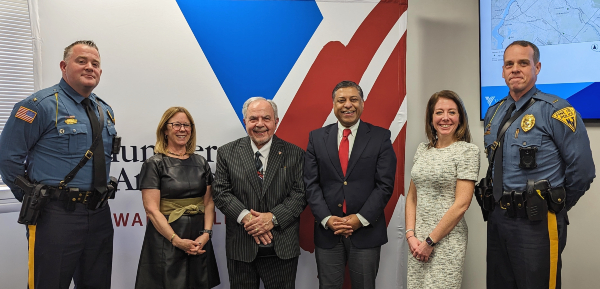
Pine Hill police and members of the Volunteers of America IMPACT program team meet with ONDCP Director Rahul Gupta. Credit: Matt Skoufalos.
Winters said departments have had success proactively reaching out to community members with whom police already have a high level of engagement, and offering to help resolve their underlying issues to prevent further interactions with law enforcement.
“You want people to be able to avoid costly, crisis-oriented systems,” he said. “There’s a department culture, a desire to get individuals where they need to be through partnerships; at the end of the day, that’s what community policing is: partnerships and solving problems together.”
The IMPACT program has even helped resolve situations where police have had to use force on a person in crisis. Winters described a situation in which a resident who had serious, self-inflicted wounds charged a responding officer while wielding a knife.
The officer tazed that person, administered treatment afterwards, and charges were filed. However, everyone involved determined that the best course of action would be inpatient mental health services rather than jail, Winters said.
“There were significant hurdles, but because of the tenacity of the IMPACT staff, within 24 hours, that person was transported to Bergen County inpatient, and we haven’t dealt with the individual since,” the chief said. “A correctional facility wasn’t the place for that person.
“There was no injury to the officer, and no injury to the individual other than the self-inflicted wounds,” he said. “The impact to the community was significant; what was prevented was significant.”
Next steps for the program are sourcing funding to expand the social service interventions it offers throughout more of New Jersey.
“We found something that was effective,” Winters said. “You’re not going to find a law enforcement agency or police chief in the country who doesn’t want to be part of the stabilization of his community. It’s a program that’s effective.”
Please support NJ Pen with a subscription. Get e-mails, follow us on Facebook, Twitter, and Instagram, or try our Direct Dispatch text alerts.

